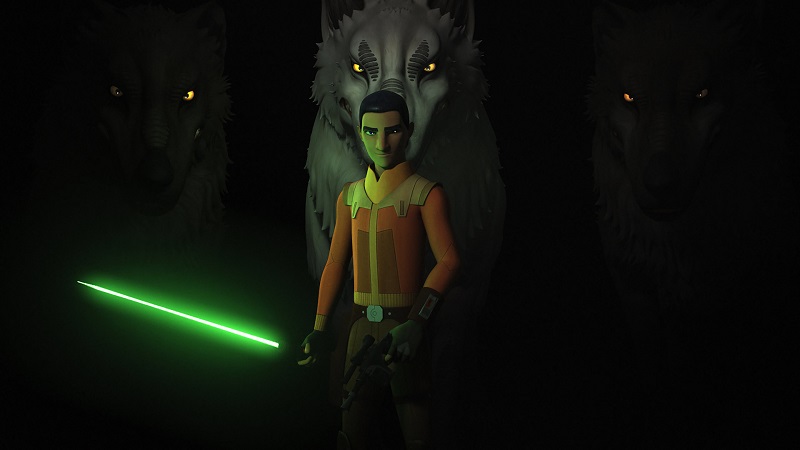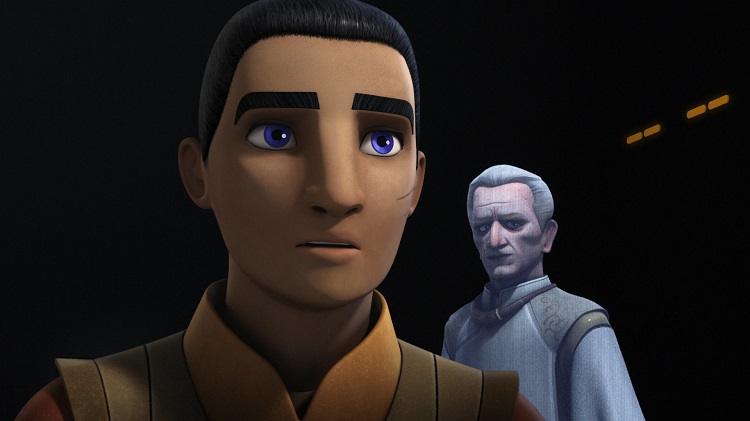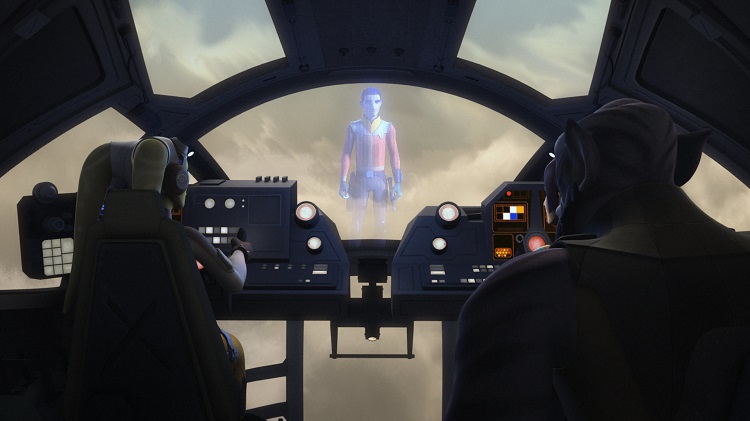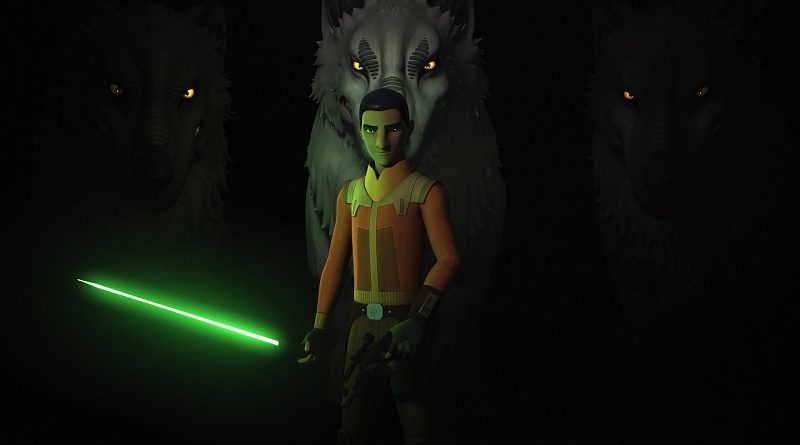Star Wars Rebels: Series Finale Review
 Many years ago, Lucasfilm invited Dave Filoni to develop and direct a new animated series for the Star Wars franchise. In his initial thoughts for the show that eventually became The Clone Wars, he described it as “a small number of characters, have them based on a Millenium Falcon-style smuggling ship, and involve them in black market trade, war espionage, and other stories that existed outside the giant galactic conflict going on in the background. The cast of characters included a Padawan learner, Ashla, and her Jedi Master who had been assigned to a crew of scoundrels, led by a smuggler similar to Han Solo. He and his girlfriend were supported by a Gungan named Lunker, the strongman of the show.” Additionally, the characters would occasionally run into the big names of the Star Wars franchise, like Obi-Wan Kenobi, but in ways that would not affect the overall canon. Switch around some genders and other facts, such as the time setting, and this was the seed of the idea that became Star Wars Rebels.
Many years ago, Lucasfilm invited Dave Filoni to develop and direct a new animated series for the Star Wars franchise. In his initial thoughts for the show that eventually became The Clone Wars, he described it as “a small number of characters, have them based on a Millenium Falcon-style smuggling ship, and involve them in black market trade, war espionage, and other stories that existed outside the giant galactic conflict going on in the background. The cast of characters included a Padawan learner, Ashla, and her Jedi Master who had been assigned to a crew of scoundrels, led by a smuggler similar to Han Solo. He and his girlfriend were supported by a Gungan named Lunker, the strongman of the show.” Additionally, the characters would occasionally run into the big names of the Star Wars franchise, like Obi-Wan Kenobi, but in ways that would not affect the overall canon. Switch around some genders and other facts, such as the time setting, and this was the seed of the idea that became Star Wars Rebels.
On March 4, Rebels concluded with “A Fool’s Hope” and “Family Reunion – and Farewell.” The airing of the series finale had two things to accomplish: not just conclude the storylines set into motion earlier in the show, but also provide a satisfying end to the story overall that began with the show’s first episode, “A Spark of Rebellion.” One can safely argue that the latter of these two goals began with the second half of the fourth season, starting with the death of Kanan Jarrus. Rebels did succeed in both goals, but it did so tenuously at times and asked its fans to simply accept the conclusion.
Thankfully, the weakest of the two episodes was “A Fool’s Hope,” which had the unfortunate position of being situated in the middle of five episodes, where the two episodes on either side are better paired off together than with it. It opened in media res, with Hera in the Ghost meeting up with familiar faces to ask them to sign on the mission of freeing Lothal. In “Rebel Assault,” the mid-season finale of Season Four, the Rebel Alliance did the same thing, a plan that ended in absolute failure due to Grand Admiral Thrawn’s preparation for such an attack. This time, it’s simply the rebels of Lothal (not the rebels of the Rebel Alliance) seeking to do the same with far fewer resources.
This is our first indication of problematic writing in the finale, bending words to accommodate the existing canon for the purpose of achieving a desired effect without contradicting what’s already been established. That ultimate effect being a major victory over the Empire before the Battle of Scarif. Previously, this was best displayed by Ahoska Tano’s fierce statement “I am no Jedi” in Season Two of the show. Tano’s rejection of this label provided an out for the Force user from Return of the Jedi’s Yoda assertion that Luke would be the last of the Jedi once the little green Jedi Master became one with the Force. Now in Rebels, by distinguishing our rebels from the Rebels, it pulls any happy ending against the Empire (a major victory) out of the win column for the Rebel Alliance – preserving the honor for the aforementioned Battle of Scarif, referenced in the crawl of A New Hope. Later in “Family Reunion – and Farewell,” the writers go full Tolkien, but not in a good way.
 In “A Fool’s Hope” we learn that the first step in Ezra Bridger’s plan to liberate his home world is capturing Governor Arindha Pryce. The plan begins with Clancy Brown’s Ryder Azadi, former governor of Lothal, appearing to betray the location of the rebels’ secret camp in exchange for his freedom. Despite previous minor disagreements with Ezra on the ability to liberate the planet with their paltry resources, little has been done to develop Ryder’s character to be one which viewers would expect to betray his allies. The writers tried to portray it with the animation of Ryder slinking around the rebel base when the Imperial forces attack until it’s revealed, as a surprise to Pryce, that Ryder did not, in fact, betray his friends. Sadly, Ezra’s plan is so terrible, due to the rebels seemingly being caught by surprise by Pryce’s attack and being virtually defeated, that it almost did appear as if Ryder betrayed his friends. The writing almost seemed to work backwards to justify something it set into motion already. The day is only saved when the giant eagles of the Misty Mountains – sorry, the Loth-wolves – appear out of nowhere and defeat the Imperial forces (and capture Pryce) for the rebels.
In “A Fool’s Hope” we learn that the first step in Ezra Bridger’s plan to liberate his home world is capturing Governor Arindha Pryce. The plan begins with Clancy Brown’s Ryder Azadi, former governor of Lothal, appearing to betray the location of the rebels’ secret camp in exchange for his freedom. Despite previous minor disagreements with Ezra on the ability to liberate the planet with their paltry resources, little has been done to develop Ryder’s character to be one which viewers would expect to betray his allies. The writers tried to portray it with the animation of Ryder slinking around the rebel base when the Imperial forces attack until it’s revealed, as a surprise to Pryce, that Ryder did not, in fact, betray his friends. Sadly, Ezra’s plan is so terrible, due to the rebels seemingly being caught by surprise by Pryce’s attack and being virtually defeated, that it almost did appear as if Ryder betrayed his friends. The writing almost seemed to work backwards to justify something it set into motion already. The day is only saved when the giant eagles of the Misty Mountains – sorry, the Loth-wolves – appear out of nowhere and defeat the Imperial forces (and capture Pryce) for the rebels.
The development of the Loth-wolves as the deus ex machina which saves Ezra’s plan actually makes sense due to the build up in Bridger’s relationship with them up to this point. In execution, their use as a planned instrument to capture Pryce felt more ad hoc and somewhat clumsy, as the same effect could have happened sooner in the fight without the poor surprise reveal that Ryder was still indeed loyal. Yet when the Ghost and Hera’s recruited allies arrive prior to the Loth-wolves, it’s treated as the effective means planned by Ezra all along. Nonetheless, it goes awry when the battle hardened Ghost suddenly has trouble with armed shuttles. It’s a weird drop in capability for a ship that has often tangled with Imperial TIE fighters, even the TIE Defender, and handled them well. But ultimately Pryce is captured, and so ends “A Fool’s Hope,” one of the more poorly written Rebels episodes of the season. It suffered mainly from a sense that things happen just to happen with all eyes gazing forward to the next episode.
“Family Reunion – and Farewell” begins right where “A Fool’s Hope” ends. The rebels use a captured Pryce as their means to enter the Imperial command facility, the giant mushroom dome-shaped building that dominates the Lothal capital’s skyline.
A sense of urgency exists through the episode based on the timing of Grand Admiral Thrawn’s return from meeting with the Emperor on Coruscant. From the beginning of Season Three when Thrawn was introduced as the new antagonist of the show, Rebels had a problem – how do you deal with one of the greatest strategic minds of the Empire? This was a concern of the writers that affected how that season unfolded. It resulted in rebel defeat after defeat, and in the finale of that season, the rebels escaped purely due to the self-sacrifice of Commander Sato, the arrogance of Admiral Konstantine, and the intervention of the Bendu. Thus, to have the happy ending that the writers wanted for the conclusion of the show, they needed to deal with the Thrawn problem.
In Thrawn’s original appearance in the franchise, the blue-skinned Chiss was undone by his bodyguard and assassin, Rukh. The four limbed Noghri assassinated the grand admiral, an event that came from so far left field that Thrawn was taken by surprise. The writers counted on this story from the Legends universe to tempt fans with believing that Thrawn could meet the same fate in Season Four with the introduction of Rukh. However, the moment Rukh died inside the Imperial installation in the middle of the episode, that possibility vanished. By design, the writers had removed – and understandably so, in order to take their own path with Thrawn’s character – one potential means of defeating Thrawn.
 Instead, the writers chose something even more remote than personal betrayal: space whales, a/k/a the purrgil. Originally introduced in Season Two of the show in what the writers defiantly declared was a “not filler!” episode, the payoff was a long time coming. “The Call” was an uneventful episode about the rebels stealing fuel from the Mining Guild to supply the Rebel Alliance. In the course of the episode, purrgil are revealed to be organic beings with the capability to jump through hyperspace, and Ezra is shown to have an affinity with the intergalactic creatures. Quality-wise, the episode ranks as one of the worse in the best season of the show, but apparently, it was written in part to establish the means to carry out Thrawn’s demise through a turn of events so absurd the grand strategist could not possibly have predicted or planned to counter it. Storytelling does have a history of introducing some kind of wildlife or mass of creatures as a means for the hero to achieve victory. Very recently in fact, one could have watched the poorly performing The Legend of Tarzan, or before it The Rundown, or even more recently, “A Fool’s Hope.” Within a narrative heartbeat, Ezra’s special connection with mythic creatures acts as a deus ex machina to achieve victory for the good guys – for a second time in a row. It’s repetitive and uninspired to see the same trick played twice in such close proximity, and it reduces Ezra’s planning ability to simply, “I’ll summon some animals with my special ability when everything else fails!” The result is that the climax of the show is lessened by the writers failing to ditch one miraculous creature save for the other. Given the problem of dealing with Thrawn and the long term setup for handling the Grand Admiral, it would have made more sense to alter or remove the Loth-wolves contribution in “A Fool’s Hope” for the purpose of not giving viewers a minor form of déjà vu.
Instead, the writers chose something even more remote than personal betrayal: space whales, a/k/a the purrgil. Originally introduced in Season Two of the show in what the writers defiantly declared was a “not filler!” episode, the payoff was a long time coming. “The Call” was an uneventful episode about the rebels stealing fuel from the Mining Guild to supply the Rebel Alliance. In the course of the episode, purrgil are revealed to be organic beings with the capability to jump through hyperspace, and Ezra is shown to have an affinity with the intergalactic creatures. Quality-wise, the episode ranks as one of the worse in the best season of the show, but apparently, it was written in part to establish the means to carry out Thrawn’s demise through a turn of events so absurd the grand strategist could not possibly have predicted or planned to counter it. Storytelling does have a history of introducing some kind of wildlife or mass of creatures as a means for the hero to achieve victory. Very recently in fact, one could have watched the poorly performing The Legend of Tarzan, or before it The Rundown, or even more recently, “A Fool’s Hope.” Within a narrative heartbeat, Ezra’s special connection with mythic creatures acts as a deus ex machina to achieve victory for the good guys – for a second time in a row. It’s repetitive and uninspired to see the same trick played twice in such close proximity, and it reduces Ezra’s planning ability to simply, “I’ll summon some animals with my special ability when everything else fails!” The result is that the climax of the show is lessened by the writers failing to ditch one miraculous creature save for the other. Given the problem of dealing with Thrawn and the long term setup for handling the Grand Admiral, it would have made more sense to alter or remove the Loth-wolves contribution in “A Fool’s Hope” for the purpose of not giving viewers a minor form of déjà vu.
The appearance of the purrgil did not ruin the finale, thankfully, which continued toward the only foregone conclusion – Lothal’s liberation. The removal of the Empire from a planet with valuable resources and high tech factories definitely counts as a major victory against Palpatine’s regime, which calls back the beginning of “A Fool’s Hope,” when Hera flatly denies that the operation in mind is one being orchestrated by the Rebel Alliance. This phrasing spared the Star Wars franchise from dealing with a story that contradicts the very first piece of information gleamed at the release of the film in 1977. As fans, we are asked to accept this argument, and for the sake of the series, it is acceptable, given again that Rebels made Lothal one of the main driving forces of the show’s storytelling and character motivations. What is Ezra Bridger without Lothal?
Ezra’s dedication to his friends and Lothal are what constitutes the major story element of the finale, which is fair, given that young Bridger has always been the central focus of the show. In this case, after Thrawn arrives he requests Ezra to meet with him aboard his ship. Ezra accepts Thrawn’s invitation to the Chimera where he is escorted to a segment of Lothal’s Jedi temple that Thrawn has had rebuilt inside the hold of his Star Destroyer. There, Ezra engages with a hologram of Emperor Palpatine who stands in for the devil and attempts to seduce Ezra by offering him the temple as a gateway to a reality where his parents still live. In exchange, Ezra must walk away from his friends and Lothal. One can argue there are Christian overtones to Palpatine’s attempt to seduce Ezra with something highly desirable after Ezra purposefully puts himself in the path of temptation, and it is followed by Ezra’s self-sacrifice to save his world and rebel friends. However, it is only a thin layer. What can be appreciated is Palpatine continuing his efforts to subvert opponents through the things they love the most, such as Anakin Skywalker and his love for Padmé Amidala. It fails with Ezra.
 Thrawn’s plans to prevent the rebels from using the planet’s shield generator also fail when the rebels successfully defeat Rukh. In the course of the firefight, the Ugnaught pal of Hondo Ohnaka lives but a clone dies, a sacrifice to give the episode a bit more of a dramatic weight. The death of Gregor feels unnecessary, with his dying breath recognizing the importance of a clone fighting for something by choice rather than by genetic design – a point that could have easily been made without a death. The death which does have the greatest impact belongs to Governor Pryce, who chooses to die with her soldiers and for the Empire rather than live defeated. It closes out Pryce’s arc that began in Timothy Zahn’s Thrawn and leaves a great narrative of how one can unintentionally become the villain in their own story through corruption by way of accepting one small immoral necessity after another. As for our other major characters, the show’s finale provided them with things to do, but Ezra generally was the focus.
Thrawn’s plans to prevent the rebels from using the planet’s shield generator also fail when the rebels successfully defeat Rukh. In the course of the firefight, the Ugnaught pal of Hondo Ohnaka lives but a clone dies, a sacrifice to give the episode a bit more of a dramatic weight. The death of Gregor feels unnecessary, with his dying breath recognizing the importance of a clone fighting for something by choice rather than by genetic design – a point that could have easily been made without a death. The death which does have the greatest impact belongs to Governor Pryce, who chooses to die with her soldiers and for the Empire rather than live defeated. It closes out Pryce’s arc that began in Timothy Zahn’s Thrawn and leaves a great narrative of how one can unintentionally become the villain in their own story through corruption by way of accepting one small immoral necessity after another. As for our other major characters, the show’s finale provided them with things to do, but Ezra generally was the focus.
In the moment following the great purrgil attack and corresponding Thrawn defeat – the creatures hyperspace him and Ezra off into the wild beyond – the creators wisely provided an epilogue through a montage narrated by Sabine. This was the true closure, albeit a hurried one which left a lot of room for expansion should the powers that be deign to tell the story of any one of the characters in more detail. Everyone has what appears to be a happy ending. Kallus is redeemed through his actions for the Rebel Alliance and invited to make a home on the new Lasat homeworld along with Zeb. Hera and Rex fight through the Galactic Civil War straight through to Endor, and thanks to the cameos in Rogue One, we know that Hera and Chopper were at least at the Battle of Scarif, too. There was also the surprise bombshell that Hera was pregnant with a child, Kanan being the father, at the time of the finale. More questionably is Sabine’s fate, who implies to the audience that she sat out the Galactic Civil War waiting to help defend Lothal from a likely Imperial counterattack. We learn the counterattack never came due to the actions of the greater Rebel Alliance – which at that time was still an entity that spent its time yelling at each other before Scarif.
In short, the final moments of the show asked fans to once again simply go with what we are told by the writers. This happened because we say it did. Given that a single Star Destroyer with a ground detachment could have done plenty of damage to Lothal in retaliation, that the Imperial forces were bigger than ever and growing at that point in time, this along with Sabine’s wait felt like one of the biggest hand-wave moments of the finale. Despite the thrill of seeing Ahsoka Tano appear to take Sabine on an intergalactic hunt for Ezra in the last sequence, the finale was soured by these repeated requests by the writers.
 The undermining of the finale did not necessarily mean that “Family Reunion – and Farewell” did not serve well enough as a finale for the show in general. Rebels came into existence because Disney wanted a series of its own, instead of a continuation of The Clone Wars, and to do so without stepping onto the possibility of new ideas and directions, set the show in a time period relevant to original trilogy. As a Star Wars show it had to include certain ingredients, such as Jedi and a fierce cargo ship that flew like a feather on the wind under the deft hands of its captain. It became a base around which Disney could become comfortable as a producer of an umbrella of Star Wars material, an initial experiment while a much bigger effort was underway with what became The Force Awakens. At its heart, in the same way that George Lucas opted to make Anakin Skywalker ten years old, was a young protagonist, a point of view character for young fans to latch onto and follow along in his adventures.
The undermining of the finale did not necessarily mean that “Family Reunion – and Farewell” did not serve well enough as a finale for the show in general. Rebels came into existence because Disney wanted a series of its own, instead of a continuation of The Clone Wars, and to do so without stepping onto the possibility of new ideas and directions, set the show in a time period relevant to original trilogy. As a Star Wars show it had to include certain ingredients, such as Jedi and a fierce cargo ship that flew like a feather on the wind under the deft hands of its captain. It became a base around which Disney could become comfortable as a producer of an umbrella of Star Wars material, an initial experiment while a much bigger effort was underway with what became The Force Awakens. At its heart, in the same way that George Lucas opted to make Anakin Skywalker ten years old, was a young protagonist, a point of view character for young fans to latch onto and follow along in his adventures.
Rebels was always a show about Ezra Bridger, and by extension, the Force and Lothal. The finale episodes of the show catered exclusively to this premise, closing out a chapter that was opened from the very introduction of the Loth-rat who longed for his parents, happily poked the Imperial bear with a stick, and stumbled across rebels determined to fight the Imperial presence on his home world. While individually the episodes that closed out the series were problematic at times, in the end they offered a satisfying conclusion determined by the nature of the show, its audience, and the storytelling ideals of Star Wars.
- Star Wars The Mandalorian – The Reckoning and Redemption Review - January 15, 2020
- Star Wars: The Mandalorian –The Prisoner Review - January 11, 2020
- Star Wars Resistance – Station to Station Review - January 7, 2020











